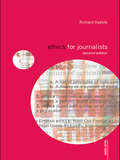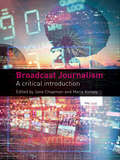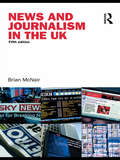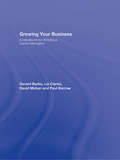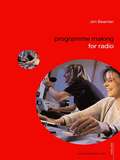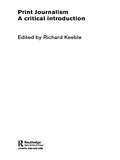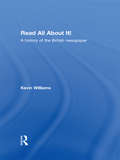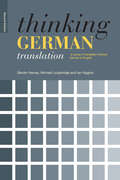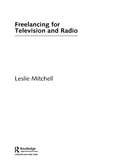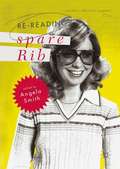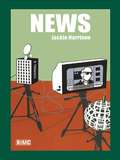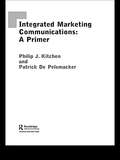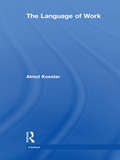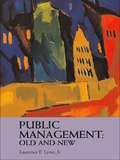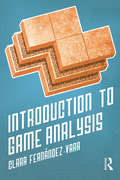- Table View
- List View
Ethics for Journalists
by Richard KeebleEthics for Journalists tackles many of the issues which journalists face in their everyday lives – from the media's supposed obsession with sex, sleaze and sensationalism, to issues of regulation and censorship. Its accessible style and question and answer approach highlights the relevance of ethical issues for everyone involved in journalism, both trainees and professionals, whether working in print, broadcast or new media. Ethics for Journalists provides a comprehensive overview of ethical dilemmas and features interviews with a number of journalists, including the celebrated investigative reporter Phillip Knightley. Presenting a range of imaginative strategies for improving media standards and supported by a thorough bibliography and a wide ranging list of websites, Ethics for Journalists, second edition, considers many problematic subjects including: representations of gender, race, sexual orientation, disability, mental health and suicide ethics online – ‘citizen journalism’ and its challenges to ‘professionalism’ controversial calls for a privacy law to restrain the power of the press journalistic techniques such as sourcing the news, doorstepping, deathknocks and the use of subterfuge the handling of confidential sources and the dilemmas of war and peace reporting.
Broadcast Journalism: A Critical Introduction
by Jane Chapman Marie KinseyBroadcast Journalism offers a critical analysis of the key skills required to work in the modern studio, on location, or online, with chapters written by industry professionals from the BBC, ITV, CNN and independent production companies in the UK and USA. Areas highlighted include: interviewing researching editing writing reporting. The practical tips are balanced with chapters on representation, ethics, law, economics and history, as well as specialist areas such as documentary and the reporting of politics, business, sport and celebrity. Broadcast Journalism concludes with a vital chapter on career planning to act as a springboard for your future work in the broadcast industry. Contributors: Jim Beaman; Jane Chapman; Fiona Chesterton; Tim Crook; Anne Dawson; Tony Harcup; Jackie Harrison; Ansgard Heinrich; Emma Hemmingway; Patricia Holland; David Holmes; Gary Hudson; Nicholas Jones; Marie Kinsey; Roger Laughton; Leslie Mitchell; Jeremy Orlebar; Claire Simmons; Katie Stewart; Ingrid Volkmer; Mike Ward; Deborah Wilson.
Broadcast Journalism: A Critical Introduction
by Jane Chapman Marie KinseyBroadcast Journalism offers a critical analysis of the key skills required to work in the modern studio, on location, or online, with chapters written by industry professionals from the BBC, ITV, CNN and independent production companies in the UK and USA. Areas highlighted include: interviewing researching editing writing reporting. The practical tips are balanced with chapters on representation, ethics, law, economics and history, as well as specialist areas such as documentary and the reporting of politics, business, sport and celebrity. Broadcast Journalism concludes with a vital chapter on career planning to act as a springboard for your future work in the broadcast industry. Contributors: Jim Beaman; Jane Chapman; Fiona Chesterton; Tim Crook; Anne Dawson; Tony Harcup; Jackie Harrison; Ansgard Heinrich; Emma Hemmingway; Patricia Holland; David Holmes; Gary Hudson; Nicholas Jones; Marie Kinsey; Roger Laughton; Leslie Mitchell; Jeremy Orlebar; Claire Simmons; Katie Stewart; Ingrid Volkmer; Mike Ward; Deborah Wilson.
News and Journalism in the UK
by Brian McNairNews and Journalism in the UK is an accessible and comprehensive introduction to the political, economic and regulatory environments of press and broadcast journalism in Britain and Northern Ireland. Surveying the industry in a period of radical economic and technological change, Brian McNair examines the main trends in journalistic media in the last two decades and assesses the challenges and future of the industry in the new millennium. Integrating both academic and journalistic perspectives on journalism, topics addressed in this revised and updated edition include: the rise of online journalism and the impact of blogging on mainstream journalism the emergence of 24 hour news channels in the UK the role and impact of journalism, with reference to issues such as democracy, health scares and the war on terror trends in media ownership and editorial allegiances 'Tabloidisation', Americanisation and the supposed 'dumbing down' of journalistic standards the implications of devolution for regional journalists.
News and Journalism in the UK
by Brian McNairNews and Journalism in the UK is an accessible and comprehensive introduction to the political, economic and regulatory environments of press and broadcast journalism in Britain and Northern Ireland. Surveying the industry in a period of radical economic and technological change, Brian McNair examines the main trends in journalistic media in the last two decades and assesses the challenges and future of the industry in the new millennium. Integrating both academic and journalistic perspectives on journalism, topics addressed in this revised and updated edition include: the rise of online journalism and the impact of blogging on mainstream journalism the emergence of 24 hour news channels in the UK the role and impact of journalism, with reference to issues such as democracy, health scares and the war on terror trends in media ownership and editorial allegiances 'Tabloidisation', Americanisation and the supposed 'dumbing down' of journalistic standards the implications of devolution for regional journalists.
Growing your Business: A Handbook for Ambitious Owner-Managers
by Liz Clarke Paul Barrow Gerard Burke David MolianGrowing Your Business helps owner/managers develop growth strategies for their businesses by providing frameworks, ideas, inspiration and hands-on assignments. Its contents are a distillation of the authors’ knowledge and experience, which has successfully helped hundreds of owner/managers to grow and develop their businesses and themselves over the last twenty years. Filled with case studies and examples of businesses involved with the world-renowned Business Growth and Development Programme (BGP) at the Cranfield School of Management, this book covers all industry sectors and includes high profile names such as Karan Bilimoria of Cobra Beer, Angus Thirlwell of Hotel Chocolat and Lara Morgan of Pacific Direct. As well as being an ideal text for courses and modules in small business development and business growth at undergraduate and MBA levels, this book also stands on its own as an invaluable 'workbook' that enables any owner manager to develop their own growth strategy and take their business to the next level.
Programme Making for Radio
by Jim BeamanProgramme Making for Radio offers trainee radio broadcasters and their instructors focused practical guidelines to the professional techniques applied to the making of radio shows, explaining how specific radio programmes are made and the conventions and techniques required to produce them. This book describes how and why these methods are applied through the use of a behind-the-scenes glimpse at working practices and procedures used in the industry. It considers the constraints and incentives that limit or stimulate creativity and innovation within programme production. Programme Making for Radio examines the individual roles and responsibilities of the whole production team and the importance of team-working skills. Chapters focus on the specific requirements of specialist programmes and offer advice from a range of programme makers working in local and national broadcasting. There is a case study example that follows the progress of a feature programme from pitching the original idea, through assembling material to final transmission. Programme Making for Radio includes: a clear description of the role of each member of the programme making team, their duties and responsibilities practical tips on interviewing, mixing and presenting explanations of the key elements that make up a radio programme such as clips, wraps, packages, features and interviews with a full glossary of technical terms. This book is informative, accessible and comprehensive, covering the whole range of skills needed by the radio professional in the studio and on location.
Programme Making for Radio
by Jim BeamanProgramme Making for Radio offers trainee radio broadcasters and their instructors focused practical guidelines to the professional techniques applied to the making of radio shows, explaining how specific radio programmes are made and the conventions and techniques required to produce them. This book describes how and why these methods are applied through the use of a behind-the-scenes glimpse at working practices and procedures used in the industry. It considers the constraints and incentives that limit or stimulate creativity and innovation within programme production. Programme Making for Radio examines the individual roles and responsibilities of the whole production team and the importance of team-working skills. Chapters focus on the specific requirements of specialist programmes and offer advice from a range of programme makers working in local and national broadcasting. There is a case study example that follows the progress of a feature programme from pitching the original idea, through assembling material to final transmission. Programme Making for Radio includes: a clear description of the role of each member of the programme making team, their duties and responsibilities practical tips on interviewing, mixing and presenting explanations of the key elements that make up a radio programme such as clips, wraps, packages, features and interviews with a full glossary of technical terms. This book is informative, accessible and comprehensive, covering the whole range of skills needed by the radio professional in the studio and on location.
Print Journalism: A Critical Introduction
by Richard KeeblePrint Journalism provides an up-to-date overview of the skills needed to work within the newspaper and magazine industries. This critical approach to newspaper and magazine practice highlights historical, theoretical, ethical and political debates and includes tips on the everyday skills of newspaper and magazine journalists, as well as tips for online writing and production. Crucial skills highlighted include: sourcing the news interviewing sub editing feature writing and editing reviewing designing pages pitching features In addition separate chapters focus on ethics, reporting courts, covering politics and copyright whilst others look at the history of newspapers and magazines, the structure of the UK print industry (including its financial organization) and the development of journalism education in the UK, helping to place the coverage of skills within a broader, critical context. All contributors are experienced practicing journalists as well as journalism educators from a broad range of UK universities.
Print Journalism: A Critical Introduction
by Richard KeeblePrint Journalism provides an up-to-date overview of the skills needed to work within the newspaper and magazine industries. This critical approach to newspaper and magazine practice highlights historical, theoretical, ethical and political debates and includes tips on the everyday skills of newspaper and magazine journalists, as well as tips for online writing and production. Crucial skills highlighted include: sourcing the news interviewing sub editing feature writing and editing reviewing designing pages pitching features In addition separate chapters focus on ethics, reporting courts, covering politics and copyright whilst others look at the history of newspapers and magazines, the structure of the UK print industry (including its financial organization) and the development of journalism education in the UK, helping to place the coverage of skills within a broader, critical context. All contributors are experienced practicing journalists as well as journalism educators from a broad range of UK universities.
Read All About It!: A History of the British Newspaper
by Kevin WilliamsThis Text-book traces the evolution of the newspaper, documenting its changing form, style and content as well as identifying the different roles ascribed to it by audiences, government and other social institutions. Starting with the early 17th century, when the first prototype newspapers emerged, through Dr Johnson, the growth of the radical press in the early 19th century, the Lord Northcliffe revolution in the early 20th century, the newspapers wars of the 1930s and the rise of the tabloid in the 1970s, right up to Rupert Murdoch and the online revolution, the book explores the impact of the newspapers on our lives and its role in British society. Using lively and entertaining examples, Kevin Williams illustrates the changing form of the newspaper in its social, political, economic and cultural context. As well as telling the story of the newspaper, he explores key topics in detail, making this an ideal text for students of journalism and the British newspaper. Issues include: newspapers and social change the changing face of regional newspapers the impact of new technology development of reporting techniques forms of press regulation
Thinking German Translation (Thinking Translation)
by Ian Higgins Sandor Hervey Michael LoughridgeThis is a comprehensive practical course in translation for advanced students of German, which focuses on improving translation quality whilst clarifying the theoretical issues involved. This second edition brings the course up-to-date, and has been fully reworked to give clearer explanations of key terms and include revised chapters on genre, compensation and revision and editing. Based on detailed analysis of translation problems, Thinking German Translation features new material taken from a wide range of sources, including: business and politics press and publicity engineering tourism literary and consumer-oriented texts. Addressing a variety of translation issues such as cultural difference, register and dialect, Thinking German Translation is essential reading for all students wishing to perfect their translation skills. It is also an excellent foundation for those considering a career in translation. Further resources, including a free teacher's handbook for the course, are available on the companion website at http://cw.routledge.com/textbooks/0415341469/resources/default.asp
Freelancing for Television and Radio
by Leslie MitchellFrom an experienced author in the field, this indispensable guide presents everything needed to create and maintain a successful freelancing career in the world of television and radio. Whether the reader is studying the field, considering their options, or currently employed as a freelance media professional, this book not only gives a brief overview of all areas, but also explains what it means to be freelance in the world of the audio-visual industry. Drawing upon real-life experiences of freelancers and freelance employers, all aspects of the job are detailed, from an outline of tax and employment issues to an analysis of the skills needed to succeed, and all the pitfalls, problems and opportunities which a career in this sector affords are clearly presented. Including: practical advice on how to start, where to find work, writing your CV and networking assessments of related sectors and their opportunities, e.g. facilities and video production an important section on developing and maintaining a freelance career key information on the challenges and responsibilities of setting up a small business a significant chapter on the basics of writing and submitting programme proposals to broadcasters useful contact information. Freelancing for TV and Radio is an absolute must for students of media studies and anyone considering, or already building a career in this hugely popular and fast-growing industry.
Freelancing for Television and Radio
by Leslie MitchellFrom an experienced author in the field, this indispensable guide presents everything needed to create and maintain a successful freelancing career in the world of television and radio. Whether the reader is studying the field, considering their options, or currently employed as a freelance media professional, this book not only gives a brief overview of all areas, but also explains what it means to be freelance in the world of the audio-visual industry. Drawing upon real-life experiences of freelancers and freelance employers, all aspects of the job are detailed, from an outline of tax and employment issues to an analysis of the skills needed to succeed, and all the pitfalls, problems and opportunities which a career in this sector affords are clearly presented. Including: practical advice on how to start, where to find work, writing your CV and networking assessments of related sectors and their opportunities, e.g. facilities and video production an important section on developing and maintaining a freelance career key information on the challenges and responsibilities of setting up a small business a significant chapter on the basics of writing and submitting programme proposals to broadcasters useful contact information. Freelancing for TV and Radio is an absolute must for students of media studies and anyone considering, or already building a career in this hugely popular and fast-growing industry.
Re-reading Spare Rib
by Angela SmithSpare Rib remains one of the most iconic symbols of Second Wave Feminism, its influence far out-living the span of its publication (1972-1993). This collection examines various aspects of the magazine - based on the digitised publication by the British Library in 2015 – in order to explore the ways in which it has influenced society in the twentieth and twenty-first centuries, as well as the lives of individual readers. By analysing several articles from a modern, post-feminist perspective, and using cross-generational interviews of Spare Rib readers and reflective accounts of reading the publication, the significance and endurance of the publication is demonstrated. Written by both academics, experienced researchers and independent scholars alike, the inter-disciplinary nature of the text results in a multi-dimensional reading of Spare Rib suitable for both an academic and general readership interested in cultural and media studies.
Re-reading Spare Rib
by Angela SmithSpare Rib remains one of the most iconic symbols of Second Wave Feminism, its influence far out-living the span of its publication (1972-1993). This collection examines various aspects of the magazine - based on the digitised publication by the British Library in 2015 – in order to explore the ways in which it has influenced society in the twentieth and twenty-first centuries, as well as the lives of individual readers. By analysing several articles from a modern, post-feminist perspective, and using cross-generational interviews of Spare Rib readers and reflective accounts of reading the publication, the significance and endurance of the publication is demonstrated. Written by both academics, experienced researchers and independent scholars alike, the inter-disciplinary nature of the text results in a multi-dimensional reading of Spare Rib suitable for both an academic and general readership interested in cultural and media studies.
News
by Jackie HarrisonFrom an author highly knowledgeable in the field, News is a handy and accessible guide that examines the history of news, both as newspapers and radio, and as entertainment and information, and introduces students to the key concepts and issues that surround the news. Using up-to-date case examples such as the Hutton Report and embedded journalists, from across a range of media including print, radio, television and the internet, Jackie Harrison explains the different theoretical approaches that have been used to study the news, as well as providing an accessible introduction to how news is produced and regulated, what counts as news, and how it is selected and presented. Topics covered include: introduction to the concept of news the growth and development of news technology, concentration and competition balancing freedom and responisibility regulatory control of the news making the news. Written in a clear and lively style, News is the ideal introductory book for students of media, communication and journalism.
News
by Jackie HarrisonFrom an author highly knowledgeable in the field, News is a handy and accessible guide that examines the history of news, both as newspapers and radio, and as entertainment and information, and introduces students to the key concepts and issues that surround the news. Using up-to-date case examples such as the Hutton Report and embedded journalists, from across a range of media including print, radio, television and the internet, Jackie Harrison explains the different theoretical approaches that have been used to study the news, as well as providing an accessible introduction to how news is produced and regulated, what counts as news, and how it is selected and presented. Topics covered include: introduction to the concept of news the growth and development of news technology, concentration and competition balancing freedom and responisibility regulatory control of the news making the news. Written in a clear and lively style, News is the ideal introductory book for students of media, communication and journalism.
A Primer for Integrated Marketing Communications
by Philip Kitchen Patrick De PelsmackerThis textbook is the first introductory primer on integrated marketing communications. It combines theory and practice to show students of marketing how different aspects of integrated marketing communications (IMC) work together. Setting the scene in which IMC has emerged, the authors explain each component of the promotional mix and go on to explain the process of functional integration. The text includes key case studies on companies, including Proctor and Gamble, NSPCC and Ardi, illustrating the practical side of IMC in addition to an introduction to the main theories at work. Including an additional Study Guide at the back, this book will be a valuable resource for students of marketing and marketing communications.
A Primer for Integrated Marketing Communications
by Philip Kitchen Patrick De PelsmackerThis textbook is the first introductory primer on integrated marketing communications. It combines theory and practice to show students of marketing how different aspects of integrated marketing communications (IMC) work together. Setting the scene in which IMC has emerged, the authors explain each component of the promotional mix and go on to explain the process of functional integration. The text includes key case studies on companies, including Proctor and Gamble, NSPCC and Ardi, illustrating the practical side of IMC in addition to an introduction to the main theories at work. Including an additional Study Guide at the back, this book will be a valuable resource for students of marketing and marketing communications.
The Language of Work
by Almut KoesterThe Intertext series has been specifically designed to meet the needs of contemporary English Language Studies. Working with Texts: A Core Introduction to Language Analysis (second edition 2001) is the foundation text, which is complemented by a range of 'satellite' titles. These provide students with hands-on practical experience of textual analysis through special topics, and can be used individually or in conjunction with Working with Texts. The Language of Work: examines how language is used in business and the workplace, looking at a range of situations and data: from meetings to informal negotiations, promotional letters to emails explores representations of work in advertising, career magazines and workplace talk looks at the way people in business interact through small talk, politeness, customer care and management-employee relationships is illustrated with lively examples taken from the real world and includes a full index of terms features a useful section on entering the world of work, exploring job adverts and texts that give advice on CV writing and developing 'transferable skills'.
The Language of Work
by Almut KoesterThe Intertext series has been specifically designed to meet the needs of contemporary English Language Studies. Working with Texts: A Core Introduction to Language Analysis (second edition 2001) is the foundation text, which is complemented by a range of 'satellite' titles. These provide students with hands-on practical experience of textual analysis through special topics, and can be used individually or in conjunction with Working with Texts. The Language of Work: examines how language is used in business and the workplace, looking at a range of situations and data: from meetings to informal negotiations, promotional letters to emails explores representations of work in advertising, career magazines and workplace talk looks at the way people in business interact through small talk, politeness, customer care and management-employee relationships is illustrated with lively examples taken from the real world and includes a full index of terms features a useful section on entering the world of work, exploring job adverts and texts that give advice on CV writing and developing 'transferable skills'.
Public Management: Old and New
by Laurence E. Lynn Jr.Offering much more than a purely theoretical or retrospective view of public management, this exciting text is an invaluable new addition to the field of public management. Putting the American model in perspective, it establishes the historical, theoretical, analytical, practical and future foundations for the comparative study of public management. Taking a boldly integrative approach, Laurence E. Lynn Jr. combines topics of best practice, performance, accountability and rule of law to provide a much-needed umbrella view of the topic. Well-written and illustrated with case study examples, this is one of the most exciting books on public management available today. As such it is an essential read for every student of public management, administration and public policy.
Public Management: Old and New
by Laurence E. Lynn Jr.Offering much more than a purely theoretical or retrospective view of public management, this exciting text is an invaluable new addition to the field of public management. Putting the American model in perspective, it establishes the historical, theoretical, analytical, practical and future foundations for the comparative study of public management. Taking a boldly integrative approach, Laurence E. Lynn Jr. combines topics of best practice, performance, accountability and rule of law to provide a much-needed umbrella view of the topic. Well-written and illustrated with case study examples, this is one of the most exciting books on public management available today. As such it is an essential read for every student of public management, administration and public policy.
Introduction to Game Analysis
by Clara Fernández-VaraGame analysis allows us to understand games better, providing insight into the player-game relationship, the construction of the game, and its sociocultural relevance. As the field of game studies grows, videogame writing is evolving from the mere evaluation of gameplay, graphics, sound, and replayablity, to more reflective writing that manages to convey the complexity of a game and the way it is played in a cultural context. Introduction to Game Analysis serves as an accessible guide to analyzing games using strategies borrowed from textual analysis. Clara Fernández-Vara’s concise primer provides instruction on the basic building blocks of game analysis—examination of context, content and reception, and formal qualities—as well as the vocabulary necessary for talking about videogames' distinguishing characteristics. Examples are drawn from a range of games, both digital and non-digital—from Bioshock and World of Warcraft to Monopoly—and the book provides a variety of exercises and sample analyses, as well as a comprehensive ludography and glossary.
